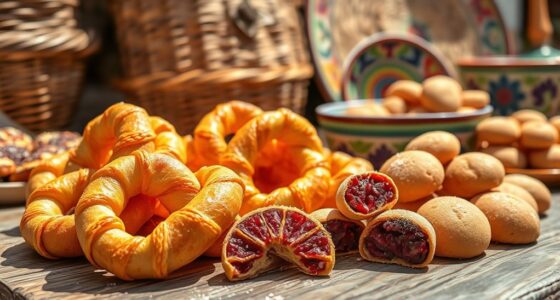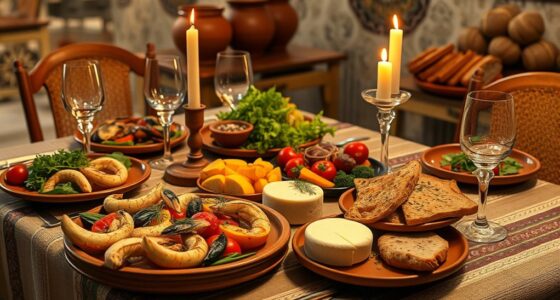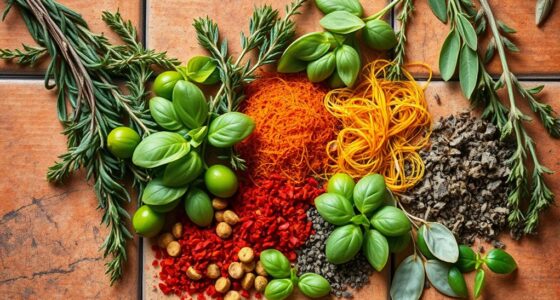In Sardinia, coastal cuisine centers on fresh seafood like lobster, octopus, and shellfish, often grilled or boiled to highlight natural flavors, with ingredients like bottarga and fregola shaping seaside dishes. Inland, hearty meats such as porceddu, lamb, and cured products dominate, prepared through slow roasting, braising, and smoking, often paired with strong cheeses and herbs. To discover how these regional flavors and techniques create unique culinary identities, keep exploring the island’s rich food traditions.
Key Takeaways
- Coastal cuisine emphasizes fresh seafood like lobster, octopus, and fregola with simple grilling, boiling, and minimal seasoning to highlight natural flavors.
- Inland dishes focus on hearty meats such as porceddu, lamb, and wild boar, prepared through slow roasting, braising, and smoking techniques.
- Coastal ingredients include sea herbs, bottarga, and shellfish, while inland ingredients feature cheeses, cured meats, mountain herbs, and wild game.
- Coastal cuisine reflects maritime traditions with resourcefulness and sustainability, whereas inland cuisine emphasizes rustic, pastoral flavors rooted in agrarian practices.
- Regional influences shape flavors: the coast favors light, seafood-centric dishes, while the inland showcases bold, robust flavors from herbs and cured meats.
Distinctive Seafood Delights of Coastal Sardinia
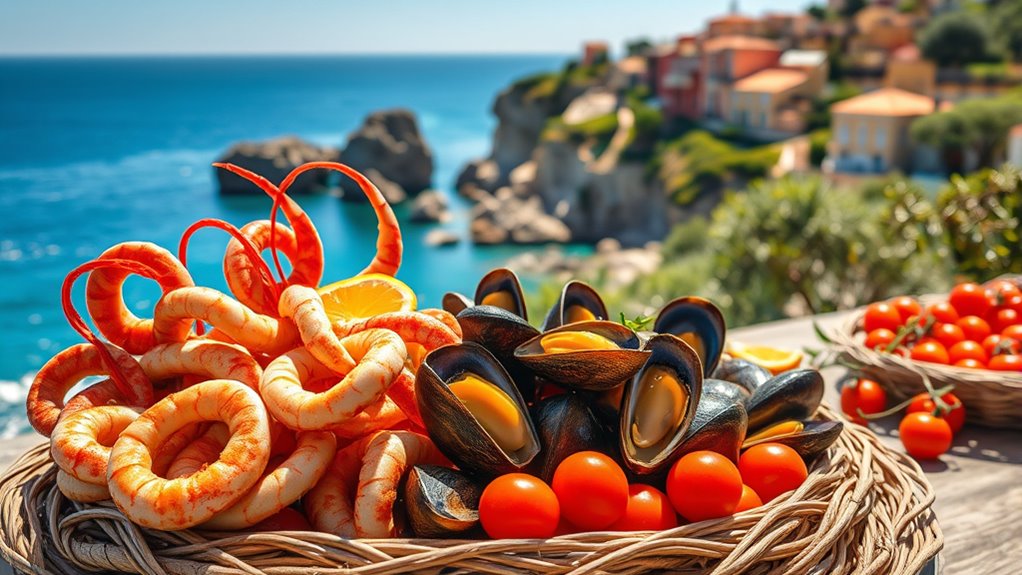
Coastal Sardinia offers a vibrant array of seafood dishes that showcase the island’s rich marine resources. You’ll find fregola with clams, where toasted semolina balls cook with fresh shellfish in seafood broth, highlighting local flavors. Bottarga di Muggine, salted and cured fish roe, graces pasta with its rich umami taste. Lobster alla Catalana, a simple, fresh boiled lobster salad with tomatoes and onions, reflects Catalan influence, especially in Alghero. During season, you can indulge in spaghetti ai ricci di mare, featuring briny sea urchin with a creamy texture. Deep-fried anemones, though rare now, once added a coastal delicacy to your dining experience. These dishes illuminate Sardinia’s seafood traditions, emphasizing freshness, local ingredients, and sustainable practices rooted in the island’s maritime culture. Sardinian seawater is known for its purity and mineral richness, preserving the natural sweetness of seafood and enhancing flavor.
The Heart of Inland Sardinian Meat Dishes
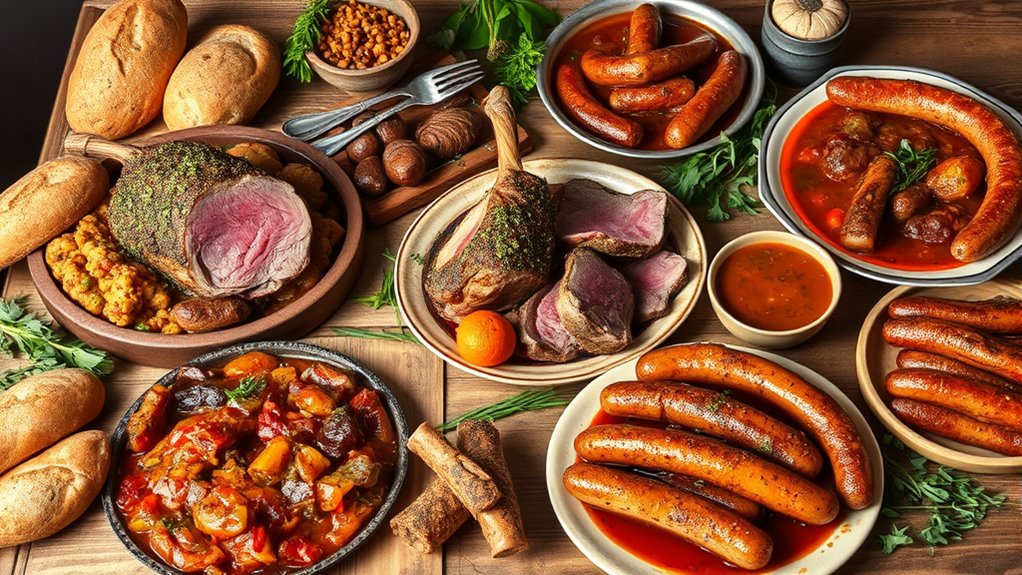
Inland Sardinian cuisine is renowned for its hearty meat dishes that reflect the island’s rugged landscape and pastoral traditions. You’ll find signature dishes like porceddu, a milk piglet slow-roasted over aromatic woods until crispy and tender. Pecora in cappotto, a mountain sheep stew with carrots, potatoes, sun-dried tomatoes, and herbs, exemplifies rustic flavors. Lamb is widely used, from lamb’s feet in tomato sauce to bone-in lamb cooked with artichokes and olives, embodying a nose-to-tail approach. Lamb liver with olives also highlights local specialties. These dishes showcase techniques like slow roasting and stewing, emphasizing local herbs and sun-dried ingredients. They’re cultural symbols of Sardinia’s pastoral roots and rural lifestyle, often enjoyed at family gatherings or festivals. Sardinia’s agriculture heavily influences these traditional recipes, contributing to their robust flavors and reliance on locally sourced ingredients. Additionally, the use of traditional cooking methods preserves the authenticity and depth of flavor unique to Sardinian inland cuisine.
Signature Ingredients That Define the Regions
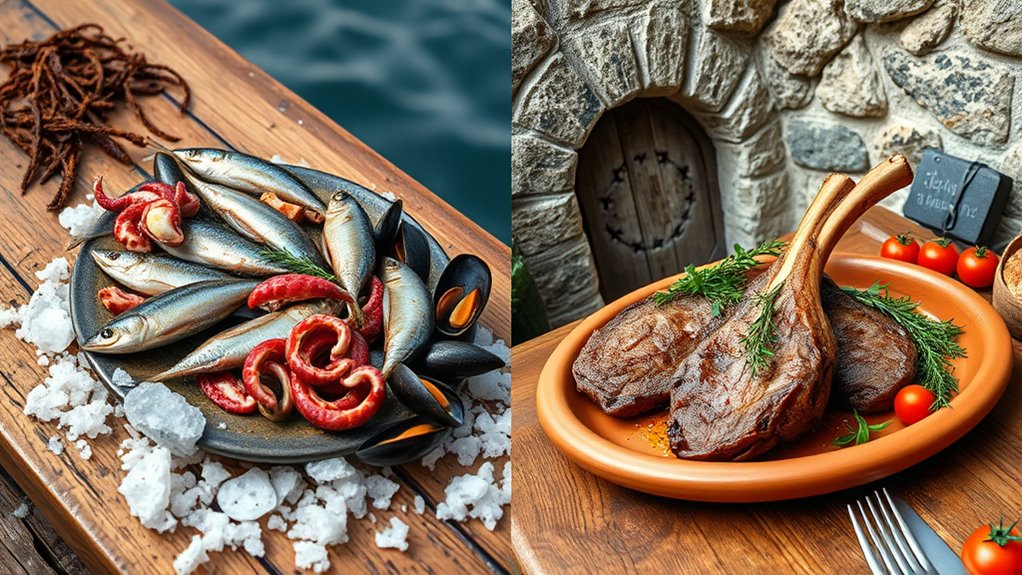
You’ll notice that coastal Sardinian cuisine centers around fresh seafood like tuna, octopus, and mullet, with bottarga adding a salty punch. Seafood is often prepared with simple, local techniques that highlight their natural flavors and freshness. Incorporating mindful preparation methods enhances the appreciation of these delicate ingredients. Inland, sheep’s milk cheeses such as Pecorino and hearty grains like pane carasau shape the flavors, often complemented by local herbs like myrtle. These signature ingredients clearly define the distinct tastes and traditions of each region.
Coastal Seafood Staples
Sardinian coastal cuisine is defined by a handful of signature ingredients that highlight the region’s rich maritime heritage and commitment to sustainability. You’ll find sea urchins (ricci di mare) at the heart of seasonal dishes, harvested responsibly to protect marine life. Fresh seafood like fish a la Scabecciu, marinated in olive oil, vinegar, and herbs, reflects local flavors. Lobster, especially in Alghero, showcases Catalan influences with boiled preparations served with tomatoes and onions. Fried anemones, coated in flour and semolina, offer a rare but distinctive coastal delicacy. Seafood fregola with saffron exemplifies the region’s love for small pasta paired with mixed seafood. These ingredients, combined with aromatic herbs like bay and myrtle leaves, define Sardinia’s vibrant coastal culinary identity. Sardinia’s coastal waters are teeming with a diverse array of marine life, allowing for a rich variety of fresh ingredients to be used in local dishes.
Inland Cheeses & Meats
Among the signature ingredients that define Sardinia’s inland culinary landscape, cheeses and cured meats hold a place of prominence. You’ll find pecorino, made from sheep’s milk, as the most iconic cheese—ranging from fresh to aged, with varieties like pecorino sardo, pecorino romano, and fiore sardo, all protected by DOP status. Goat’s milk is used for traditional cheeses like casu axedu, while cow’s milk remains rare in authentic inland recipes. Cheeses are crafted from raw, unpasteurized milk, often aged or smoked, resulting in bold flavors. Many of these cheeses undergo traditional aging processes that enhance their distinct taste. For meats, sheep and lamb dominate, along with cured products like lonzu and pancetta, and game meats such as wild boar. These ingredients feature in rustic stews, roasted dishes, and pasta fillings, highlighting the importance of regional ingredients that define Sardinia’s inland culinary identity.
Unique Sardinian Herbs
Unique Sardinian herbs play a vital role in defining the island’s regional flavors, with each variety adapted to its specific environment. Coastal herbs like myrtle, rosemary, bay leaves, thyme, and juniper infuse dishes with aromatic, resinous, and sweet notes, echoing the salty air and sun-drenched landscape. Inland herbs such as fennel seeds, tarragon, flat-leaf parsley, arugula, and masic bring a peppery, anise, and licorice complexity to soups, sauces, and meat dishes, reflecting mountain freshness. These herbs are woven into Sardinian life, from traditional herb mixes to liqueurs like Mirto. Their unique flavors create a vivid culinary tapestry that captures the essence of each region. Additionally, understanding the potential pitfalls of adopting new ingredients can help preserve the authenticity of these regional flavors.
Traditional Cooking Techniques Across the Island
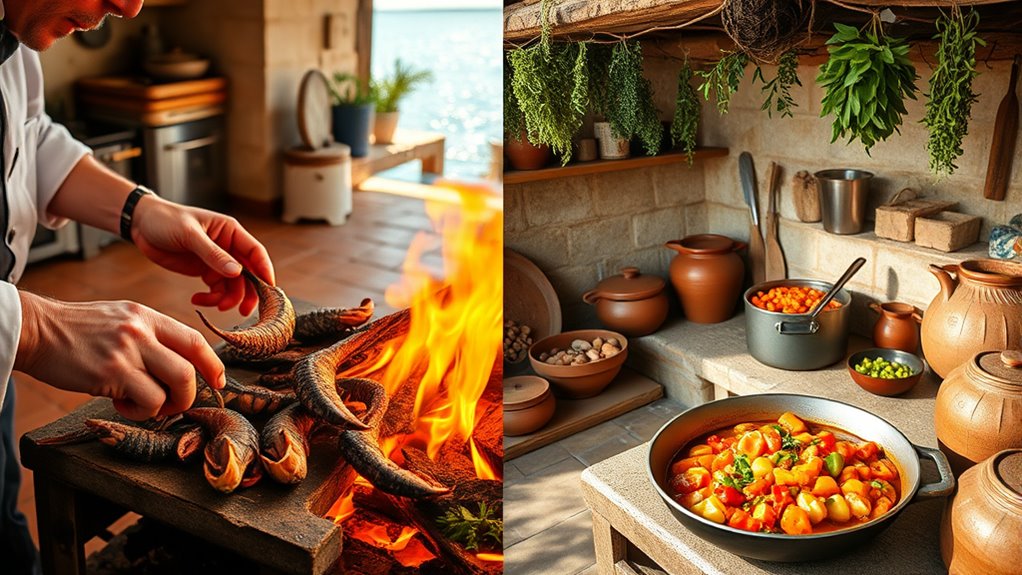
You’ll notice that Sardinian cooking varies by region, with coastal areas favoring grilling and sautéing to highlight fresh seafood, while inland communities often roast and braise meats for richer flavors. Preservation methods like curing and smoking also play a big role, helping communities store food for the long seasons. These techniques reflect the island’s diverse landscape and cultural influences, shaping each region’s unique culinary identity. Many recipes and methods are protected by PDO status, ensuring that traditional techniques and flavors are preserved for future generations.
Coastal Grilling and Sautéing
Coastal Sardinian cooking emphasizes simplicity and freshness, with grilling and sautéing serving as key techniques to highlight the natural flavors of seafood. When grilling, you’ll often cook fish and shellfish over olive wood or juniper embers, keeping seasoning minimal to preserve their delicate taste. Whole fish, like gattuccio marino, stay moist and tender, with herbs like myrtle or rosemary added after grilling for aroma. Sautéing involves lightly cooking fresh fish or shellfish in extra virgin olive oil, garlic, and parsley, sometimes with a splash of vinegar for brightness. Nuts such as walnuts are used in sauces to add richness. These methods reflect a focus on quick, high-heat techniques that emphasize quality ingredients and the natural, vibrant flavors of Sardinian marine life. Incorporating traditional cooking techniques ensures the authentic taste and preserves the island’s culinary heritage.
Inland Roasting and Braising
In inland Sardinian cuisine, slow roasting and braising are traditional techniques that bring out rich, tender flavors in hearty meats. Porceddu, a whole suckling pig roasted over wood fires with aromatic herbs, is a festive example. Terra cotta pots are essential for even heat and moisture, making tough cuts melt-in-your-mouth tender. Herbs like myrtle, rosemary, and thyme, along with woods such as juniper and oak, infuse dishes with distinctive smoky flavors. These methods exemplify creative practice, where traditional techniques are employed to enhance the culinary experience.
Preservation and Curing Techniques
Sardinian culinary traditions have long relied on preservation and curing techniques to extend the shelf life and intensify the flavors of local ingredients. You’ll notice salting and drying are common methods—covering fish or meat in salt to preserve and flavor them, or drying pork in the cool winter air to break down fats and proteins. Sea salt plays a crucial role in curing hams and seafood, emphasizing natural ingredients. The unique double-toasting process in Pane Carasau helps dry and preserve bread. Preservation also involves fermentation, aging in cellars, and the use of mineral-rich seawater to maintain seafood’s tenderness without artificial additives. Honey from native nectar plants adds natural preservative qualities, while oil rubs and occasional smoking protect meats during aging. These techniques reflect Sardinia’s resourcefulness and respect for natural ingredients. Traditional methods have been carefully maintained to ensure the continuation of authentic flavors and cultural practices across generations.
The Cultural Significance of Local Food Practices

Local food practices in Sardinia hold deep cultural significance because they embody the island’s history, identity, and social values. You’ll notice how agrarian cycles and seasonal rhythms shape what’s prepared and shared, reflecting a close bond with the land. For example, breads like *pane carasau* symbolize community and tradition, rooted in daily rural life. Dishes such as *pecora in cappotto* connect meals to shepherding and pastoral customs. Food also marks celebrations, reinforcing social cohesion and intergenerational bonds through shared preparation. It acts as a symbol of regional pride, emphasizing local ingredients and terroir. These practices resist modern influences, preserving Sardinia’s unique heritage and serving as living expressions of its history, community, and cultural resilience. Traditional dishes like malloreddus and culurgiones showcase regional craftsmanship and seasonal ingredients, further reinforcing local identity. Additionally, the use of local ingredients underscores a commitment to sustainable practices and preserving traditional farming methods.
Popular Dishes Unique to Coastal Areas
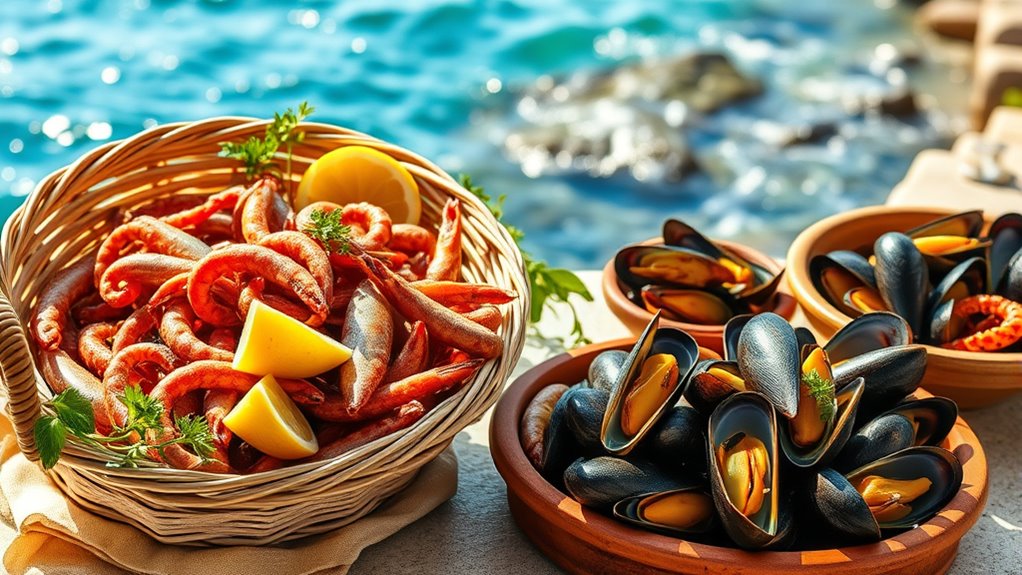
Coastal areas of Sardinia boast a vibrant culinary scene centered around the sea’s bounty. You’ll find seafood-based pasta dishes like Spaghetti alla Bottarga, where briny cured fish roe flavors the pasta with garlic, chili, and olive oil. Fregola with clams or mussels showcases toasted semolina pasta simmered with fresh shellfish, highlighting local catches. Mussels, clams, and prawns are prepared simply—steamed or added to seafood stews—preserving their freshness. Coastal cheeses like Pecorino Sardo and soft Casizolu cheese complement these dishes, often layered with bread like Pane Carasau or used in traditional recipes such as Zuppa Gallurese, a cheese and bread casserole. These dishes emphasize freshness, resourcefulness, and the rich maritime heritage that defines Sardinia’s coastal cuisine. Additionally, understanding the 16PF traits of individuals can help in appreciating the social and cultural dynamics behind traditional food sharing and culinary practices in coastal communities.
Classic Inland Sardinian Culinary Creations

Inland Sardinia boasts a rich culinary tradition centered around hearty meats, cheeses, and rustic bread. You’ll find dishes like *Porceddu*, a whole roast suckling pig flavored with myrtle leaves and slow-cooked to perfection. Lamb is a staple, featured in preparations like lamb’s feet in tomato sauce or chunks with artichokes and olives. Lamb liver served with olives showcases nose-to-tail eating. Shepherds enjoyed *ispinadas*, small meat skewers quick to prepare. Unique inland delicacies include *lumache*, boiled and stuffed snails with pecorino, garlic, and parsley.
| Dish | Main Ingredients | Special Feature |
|---|---|---|
| Porceddu | Suckling pig, myrtle leaves | Slow-roasted, served on cork trays |
| Culurgiones | Potatoes, pecorino, mint | Stuffed pasta like wheat ears |
| Zuppa Gallurese | Bread, lamb broth, cheese | Baked, casserole-style |
How Geography Shapes Sardinian Flavors
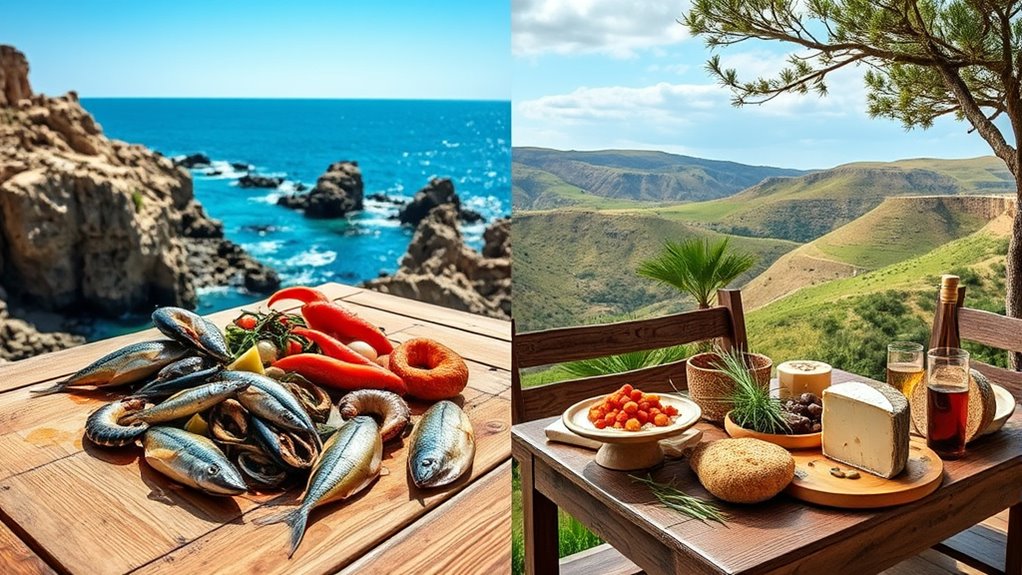
The rugged landscape and proximity to the Mediterranean Sea deeply influence Sardinia’s culinary identity. You’ll notice that coastal areas focus on fresh seafood, with dishes like lobster, octopus salad, and bottarga highlighting minimalistic preparations that preserve natural flavors. Coastal towns such as Alghero and Santa Maria Navarrese emphasize simple cooking methods like grilling or boiling, often using local herbs and sea salt for seasoning. The geography supports wetlands and lagoons, providing ingredients like mullet and shellfish, while rocky coasts offer sea herbs and crustaceans. Regional specialties, influenced by local culture and geography, include Catalan-inspired lobster recipes and seafood soups rich in spice and flavor. This landscape shapes ingredients and techniques, creating a vibrant, fresh, and authentic coastal cuisine. The abundance of marine resources also encourages sustainable fishing practices and seasonal availability, further defining the character of seaside dishes. Additionally, the local climate benefits seafood preservation, ensuring freshness and supporting traditional methods.
Frequently Asked Questions
How Do Coastal and Inland Sardinian Cuisines Differ in Flavor Profiles?
You notice that flavors differ markedly based on whether you’re near the coast or inland. Coastal dishes highlight the freshness of seafood, with bright, citrusy, and herbal notes that enhance natural tastes. Inland, you experience richer, deeper flavors from slow-cooked meats, seasoned with wild herbs, and often smoky or savory. The contrast creates a distinct taste experience, with coastal flavors feeling light and vibrant, while inland ones are hearty and robust.
What Role Do Local Herbs Like Myrtle Play in Sardinian Dishes?
You’ll find that local herbs like myrtle play a essential role in Sardinian dishes, adding aromatic depth and regional character. Myrtle enhances both savory and sweet recipes, from slow-cooked meats to traditional desserts and herb soups. It’s often used fresh or dried, infusing dishes with its resinous flavor. As a symbol of Sardinian heritage, myrtle connects you to the island’s natural landscape and culinary traditions, enriching every bite.
Are There Regional Variations in Sardinian Cheese Production Methods?
Imagine a tapestry woven with diverse threads—regional variations in Sardinian cheese methods create a rich mosaic. You’ll find inland cheeses crafted by hands that follow age-old traditions, using raw milk and smoking methods, while coastal cheeses benefit from modern tools, pasteurization, and controlled aging environments. These differences shape flavors and textures, making each cheese a unique story of its land, climate, and craftsmanship, whether rustic or refined.
How Does the Island’s Geography Influence Traditional Cooking Techniques?
You see, geography shapes how Sardinians cook traditionally. Coastal areas favor grilling and simple seafood dishes to highlight freshness, while inland regions rely on slow roasting and boiling tougher meats like lamb and wild boar. The terrain influences techniques like bread-making with Pane Carasau and fermentation processes for wine. These methods adapt to local resources, ensuring preservation and flavor, creating a diverse culinary landscape across the island.
What Are the Historical Influences Shaping Sardinian Coastal and Inland Foods?
Did you know Sardinia’s culinary history is shaped by over 2,500 years of diverse influences? You’ll notice coastal foods reflect Phoenician, Roman, and Spanish traditions, emphasizing seafood like fish, shellfish, and local condiments. Inland dishes, meanwhile, draw from ancient pastoral practices, featuring hearty meats, cheeses, and preserved bread. These influences blend Mediterranean ingredients with local customs, creating a rich, distinct cuisine that mirrors the island’s unique history and geography.
Conclusion
As you explore Sardinia’s coastal and inland cuisines, you’ll see how geography transforms flavors into a vibrant mosaic. The seaside’s fresh seafood feels like a splash of the ocean itself, while inland dishes are hearty and soulful, like warm blankets on a cool night. Together, they create a culinary landscape as diverse and breathtaking as the island’s rugged cliffs and rolling hills. Your taste buds will thank you for this unforgettable, flavor-filled adventure across Sardinia.


